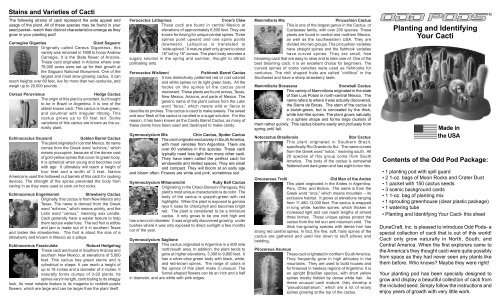Odd Pods - DuneCraft
Odd Pods - DuneCraft
Odd Pods - DuneCraft
Create successful ePaper yourself
Turn your PDF publications into a flip-book with our unique Google optimized e-Paper software.
Stains and Varieties of Cacti<br />
The following strains of cacti represent the wide appeal and<br />
usage of the plant. All of these species may be found in your<br />
seed packet– watch their distinct characteristics emerge as they<br />
grow in your planting pod!<br />
Carnegiea Gigantea Giant Saguaro<br />
Originally called Cereus Giganteus, this<br />
variety was renamed in 1908 to honor Andrew<br />
Carnegie. It is the State flower of Arizona.<br />
These cacti originated in Arizona where over<br />
78,000 acres were set up for their growth at<br />
the Saguaro National Monument. One of the<br />
largest and most slow-growing cactus, it can<br />
reach heights over 60 feet, live for more than two centuries, and<br />
weigh up to 20,000 pounds.<br />
Cereus Peruvianus Hedge Cactus<br />
The origin of this plant is uncertain, but thought<br />
to be in Brazil or Argentina. It is one of the<br />
oldest known cacti. This cactus is blue-green,<br />
and columnar with irregular ribbing. This<br />
cactus grows up to 50 feet tall. Some<br />
variations of this cactus are known as the curiosity<br />
plant.<br />
Echinocactus Grusonii Golden Barrel Cactus<br />
The plant originated in central Mexico. Its name<br />
comes from the Greek word “echinos,” which<br />
means porcupine, because of the dense coat<br />
of gold-yellow spines that cover its green body.<br />
It is spherical when young and becomes oval<br />
with age It ultimately will reach a height of<br />
four feet and a width of 3 feet. Native<br />
Americans used the hollowed out barrels of this cacti for cooking<br />
devices. The strength of the spines prevented the body from<br />
caving in as they were used to cook on hot rocks.<br />
Echinocereus Engelmannii Strawberry Cactus<br />
Originally, this cactus is from New Mexico and<br />
Texas. The name is derived from the Greek<br />
word “echinos,” which means prickly, and the<br />
Latin word “cereus,” meaning wax candle.<br />
Cacti generally have a waxier texture to help<br />
them reduce water loss. The red fruit is edible<br />
and jam is made out of it in southern Texas<br />
and tastes like strawberries. The fruit is about the size of a<br />
strawberry and known in Mexico as a pitaya.<br />
Echinocereus Fasciculata Robust Hedgehog<br />
These cacti are found in Southern Arizona and<br />
southern New Mexico, at elevations of 5,000<br />
feet. This cactus has green stems and is<br />
cylindrical in shape. It can reach a height of<br />
up to 18 inches and a diameter of 3 inches. It<br />
naturally forms clumps of 3-20 plants. Its<br />
spines vary in length, contributing to its shaggy<br />
look. Its most notable feature is its magenta to reddish-purple<br />
flowers, which are large and can be larger than the plant itself.<br />
Ferocactus Latispinus Crow’s Claw<br />
These cacti are found in central Mexico at<br />
elevations of approximately 6,500 feet. They are<br />
known for having for unique central spines. Three<br />
spines point upward and one spine points<br />
downward. Latispinus is translated to<br />
“wide-spined.” A mature plant only grows to about<br />
16" tall by 16" across. The plant body secretes a<br />
sugary solution in the spring and summer, thought to attract<br />
pollinating ants.<br />
Ferocactus Wislizeni Fishhook Barrel Cactus<br />
It has distinctively patterned red or rust colored<br />
and white spines on its light green body. All the<br />
hooks on the spines of the cactus point<br />
downward. These plants are found across, Texas,<br />
New Mexico, Arizona, and parts of Mexico. The<br />
generic name of the plant comes from the Latin<br />
word “ferus,” which means wild or fierce to<br />
describe its prickles. This cactus is used to make sweets. The sweet<br />
and sour flesh of the cactus is candied in a sugar solution. For this<br />
reason, it has been known as the Candy Barrel Cactus, as many of<br />
these plants have been used and destroyed to make candy.<br />
Gymnocalycium Mix Chin Cactus, Spider Cactus<br />
The cacti originate exclusively in South America,<br />
with most varieties from Argentina. There are<br />
over 80 varieties in this species. These cacti<br />
typically need less light than many other cacti.<br />
They have been called the perfect cacti for<br />
windowsills and limited spaces. They are small<br />
and compact. They will bloom at an early age<br />
and bloom often. Flowers are white and pink, sometimes red.<br />
Gymnocalycium Mihanovichii Ruby Ball Cactus<br />
Originating in the Chaco Boreal in Paraguay, this<br />
plant’s most unique characteristic is its color. The<br />
body of the cactus is grayish-green with red<br />
highlights. When the plant is exposed to gamma<br />
rays it loses its chlorophyll and becomes bright<br />
red. The plant is considered to be a miniature<br />
cactus. It only grows to be one inch high and<br />
has a two inch diameter. It was originally discovered growing under<br />
bushes where it was only exposed to direct sunlight a few months<br />
out of the year.<br />
Gymnocalycium Saglione<br />
This cactus originated in Argentina in a 600 mile<br />
north/south area. In addition, the plant tends to<br />
grow at higher elevations, 3,300 to 9,800 feet. It<br />
has a silver-olive green body with black, white,<br />
and red-brown spines. The range of colors in<br />
the spines of this plant make it unusual. The<br />
funnel-shaped flowers can be an inch and a half<br />
in diameter, and are white with pink edges.<br />
Mammillaria Mix Pincushion Cactus<br />
This is one of the largest genus in the Cactus, or<br />
Cactaceae family, with over 200 species. These<br />
plants are found in central and northern Mexico,<br />
as well as the southwestern USA. They are<br />
divided into two groups. The pincushion varieties<br />
have straight spines and the fishhook varieties<br />
have curved spines. They are small, free<br />
blooming cacti that are easy to raise and to take care of. One of the<br />
best blooming cacti, it is an excellent choice for beginners. The<br />
curved spines of some varieties were used as fishhooks for<br />
centuries. The chili shaped fruits are called “chillitos” in the<br />
Southwest and have a sharp strawberry taste.<br />
Mammillaria Bocasana Snowball Cactus<br />
This variety of Mammillaria originated in the state<br />
of San Luis Potosi in north-central Mexico. The<br />
name refers to where it was actually discovered,<br />
the Sierra de Bocas. The stem of the cactus is<br />
a bluish-green, but is concealed by the thick,<br />
white hair-like spines. The plant grows naturally<br />
in a sphere shape and forms large clusters of<br />
them rather quickly. This cactus blooms easily and profusely from<br />
spring until fall.<br />
Notocactus Brasilensis Star Cactus<br />
This plant originated in Southern Brazil,<br />
specifically Rio Grande do Sul. The name comes<br />
from the Greek word “notos,” meaning south. All<br />
25 species of this group come from South<br />
America. The body of the cactus is somewhat<br />
flattened and dark green and has eight to ten ribs.<br />
Oreocereus Trolli Old Man of the Andes<br />
This plant originated in the Andes in Argentina,<br />
Peru, Chile, and Bolivia. The name is from the<br />
Greek word “oros,” which means mountain – its<br />
exclusive habitat. It grows at elevations ranging<br />
from 11,480-13,000 feet. The cactus is wrapped<br />
in long white, hairlike spines, which thicken in<br />
increased light and can reach lengths of almost<br />
three inches. These unique spines protect the<br />
cactus from the hot sun and mountain cold. The<br />
thick low-growing species with dense hair has<br />
strong red central spines. In fact, the fine, soft, hairy spines of the<br />
cactus are gathered and used like down to stuff pillows and<br />
bedding.<br />
Pilocereus Azureus<br />
These cacti originated in northern South America.<br />
They frequently grow in high altitudes in the<br />
mountains. They are used to build houses and<br />
for firewood in treeless regions of Argentina. It is<br />
an upright Brazilian species, with short yellow<br />
spines mostly hidden by dense white hair. As<br />
these unusual cacti mature, they develop a<br />
“pseudocephalium,” which are a lot of wooly<br />
spines growing at the top of the cactus.<br />
Planting and Identifying<br />
Your Cacti<br />
Made in<br />
the USA<br />
Contents of the <strong>Odd</strong> Pod Package:<br />
• 1 planting pod with spill guard<br />
• 2 1-oz. bags of Moon Rocks and Crater Dust<br />
• 1 packet with 150 cactus seeds<br />
• 3 scenic background cards<br />
• 1 1-oz. bag of planting mix<br />
• 1 sprouting greenhouse (clear plastic package)<br />
• 1 watering tube<br />
• Planting and Identifying Your Cacti- this sheet<br />
<br />
<strong>DuneCraft</strong>, Inc. is pleased to introduce <strong>Odd</strong> <strong>Pods</strong>- a<br />
special collection of cacti that is out of this world!<br />
Cacti only grow naturally in North, South, and<br />
Central America. When the first explorers came to<br />
the America’s they thought cacti were quite possibly<br />
from space as they had never seen any plants like<br />
them before. Who knows? Maybe they were right!<br />
Your planting pod has been specially designed to<br />
grow and display a beautiful collection of cacti from<br />
the included seed. Simply follow the instructions and<br />
enjoy years of growth with very little work.
Planting Instructions<br />
1. Remove the planting pod, cactus mix,<br />
decorative pebbles, watering tube, seed packet,<br />
background cards and instruction sheet from the<br />
packaging and place all on a large sheet of<br />
newspaper on a clean, flat surface.<br />
NOTE: Keep the plastic packaging for use as<br />
the sprouting greenhouse.<br />
2. Massage soil bag to remove any clumps that may<br />
have formed during shipping.<br />
3. Cut soil bag across top and use the unsharpened<br />
end of a pencil to sift soil into tubes. Fill the large<br />
tubes first and then the small ones. Remove any<br />
clumps that may fall into the planting tubes.<br />
4. Fill tubes in the planting pod to within 1/4-3/8 of<br />
an inch below the top with cactus soil. Press lightly<br />
with the unsharpened end of a pencil to insure<br />
tubes are completely filled to that point.<br />
5. Brush any extra soil that may have fallen on the<br />
base away with an artist’s paintbrush or blow<br />
lightly on the base over a trash can.<br />
6. Carefully roll seeds out of the envelope on top of<br />
the soil. The seeds are very small so do this<br />
slowly. Put 7-10 seeds in the five large tubes,<br />
5-7 seeds in the two medium tubes, and 4-5<br />
seeds in the nine small tubes.<br />
• The seeds can roll out of the envelope<br />
quickly, so you may want to empty them onto<br />
a sheet of paper to insure you have enough<br />
for all the tubes.<br />
• When planting seeds, go from left to right to<br />
easily keep track of which tubes have seeds in<br />
them.<br />
Sprouting Guarantee<br />
Your <strong>Odd</strong> Pod is guaranteed to have at least 35 sprouts at the end<br />
of a sixty day period. If you do not achieve this and would like to<br />
try it again, send us your old seed pack, the UPC code, cut from<br />
packaging, and the store receipt. We will send you a replacement<br />
pack free of charge.<br />
<strong>DuneCraft</strong>, Inc.<br />
PO Box 808<br />
Chagrin Falls, Ohio 44022<br />
© <strong>DuneCraft</strong>, Inc. 2003 All Rights Reserved<br />
7. If desired, place 1/8-1/4 of an inch layer of<br />
Moon Rocks or Crater Dust over the seeds. This<br />
can also be done after the seeds have sprouted,<br />
which is the preferable method. Use the<br />
unsharpened end of a pencil to sift the gravel out,<br />
similar to the method used for the soil.<br />
8. Water each tube thoroughly using the included<br />
watering tube:<br />
• Place tube in cup of water;<br />
• Place finger tightly over end of tube to hold<br />
water;<br />
• Once tube is directly over planting pod, slowly<br />
release finger to water cacti. Smaller tubes may<br />
only absorb half or a quarter of the tube of water.<br />
The planting containers will take between 1 and<br />
5 tubes of water, depending on their size;<br />
• Repeat above for watering remaining cacti.<br />
9. Place planting pod in the included sprouting green<br />
house.<br />
10.Place greenhouse in a warm location, (either near<br />
a window or heating vent, or outside in warm<br />
temperatures) and in bright light.<br />
11.Seeds should start to sprout in one week. Water<br />
any dry tubes once a week while the cacti are<br />
sprouting. Leave the planting pod in the greenhouse<br />
for one month.<br />
12.Remove planting pod from sprouting greenhouse<br />
and place scenic background card in slots at back<br />
of planting pod. Place in permanent location in bright<br />
light, direct or indirect. A windowsill is the best<br />
location to grow your <strong>Odd</strong> Pod.<br />
Order Cool Stuff!<br />
Glow In The Dark Bases!<br />
Extra Seeds!<br />
Supplies!<br />
Visit Our Website!<br />
www.dunecraft.com<br />
Care Instructions<br />
Watering Your <strong>Odd</strong> Pod<br />
Cacti are extremely adaptable plants and can tolerate<br />
different amounts of water. Their needs vary<br />
according to season, requiring more water in the spring<br />
and summer and less in fall and winter. Within limits,<br />
cacti that receive more water will grow faster;<br />
however, it is very important not to overwater, and to<br />
let the soil dry completely between waterings. Put<br />
small amounts of water in each tube to let them<br />
absorb it quickly. Water them several times to<br />
thoroughly water. Follow the guidelines below to<br />
insure your cacti’s safe and healthy growth.<br />
Watering<br />
Schedule<br />
Spring -<br />
Summer<br />
Fall -<br />
Winter<br />
Overwatering<br />
Regular<br />
Growth<br />
every 3-4 weeks<br />
every 6-7 weeks<br />
If you dramatically overwater and need to dry the <strong>Odd</strong><br />
Pod out, try the following methods:<br />
• Remove from greenhouse and place <strong>Odd</strong> Pod in<br />
direct sunlight, or<br />
• Remove from greenhouse and place <strong>Odd</strong> Pod on<br />
heating vent for a day or two<br />
Transplanting Cacti<br />
Aggressive<br />
Growth<br />
every 1-2 weeks<br />
every month<br />
If after several waterings and about two months, all<br />
the tubes do not have cacti in them, then you may<br />
want to transplant some cacti into the empty tubes.<br />
To transplant, follow these steps:<br />
1. Water <strong>Odd</strong> Pod thoroughly<br />
2. Use pencil or tweezers to make hole in empty<br />
tube<br />
3. Gently pull cactus out by base with tweezers and<br />
put in hole<br />
4. Use tweezers to firm soil around cactus<br />
5. Water again<br />
Tips For Planting and Care<br />
• If you see mold forming, you may want to water<br />
the <strong>Odd</strong> Pod with a 1:40 mix of hydrogen<br />
peroxideand water. This will function as a safe,<br />
effective fungicide and will prevent the mold from<br />
appearing. You can also manually remove any<br />
mold.<br />
• Cacti seeds are one of the few seeds that need<br />
light to germinate. That is why they are supposed<br />
to be placed on top of the soil. However, an easy<br />
way to improve the germination rate is to place<br />
the <strong>Odd</strong> Pod in bright light or under a grow light<br />
while sprouting.<br />
• An easy way to increase the humidity in the air of<br />
the sprouting greenhouse is to soak a folded<br />
paper towel in water and place it in the<br />
greenhouse.<br />
• Another way to increase the humidity in the air of<br />
the sprouting greenhouse is to tape the side and<br />
top, as well as the hang-hold hook holes to<br />
prevent any air exchange between the outside<br />
and inside.<br />
• Not all seeds will sprout at once, although all your<br />
tubes should have cacti within a month. Each time<br />
you water for the first year or so, you have a<br />
chance of seeing additional cacti sprout. This is<br />
because some seeds have internal “seed clocks”<br />
that program them to sprout over a certain<br />
period.<br />
• Be very careful on where you place your <strong>Odd</strong><br />
Pod. It is very lightweight and can be knocked<br />
over quite easily.<br />
• Fertilize only once in both spring and summer,<br />
never in fall or winter.<br />
• Cacti prefer warm temperatures; do not let them<br />
freeze.<br />
• Keep container in bright light, direct or indirect.<br />
The garden is designed for use on windowsills,<br />
but the cacti can also grow in an office<br />
environment with adequate fluorescent lighting.<br />
• The garden can also be grown outdoors;<br />
however, do not expose the unit to rain as the<br />
container may become flooded.














